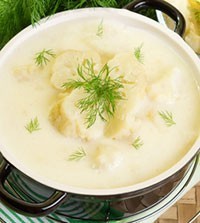First, there were Brussels sprouts. Then, kale took cooking shows and restaurant menus by storm. Now the hot new vegetable in town is cauliflower.
Cauliflower is a mild cruciferous vegetable that pairs well with almost any other vegetable. Its snow-white color shows off red peppers, orange carrots, yellow corn and cauliflower’s green cruciferous cousins, broccoli and parsley.
The many health-protective plant compounds in cauliflower and other cruciferous veggies include indoles, isoflavones and isothiocyanates, which seem to block cancer cell growth, repair DNA, inhibit inflammation (linked to cancer growth) and boost immune function.
Steamed, roasted, baked or raw, cauliflower can add vegetable cancer protection to pasta dishes, minestrone or vegetable soup or a crudité platter with hummus dip. Its mild taste adapts to almost any seasoning, including curry powder, mustard, chili powder, paprika or ginger.
Got Cauliflower?
Some easy ways to get more cauliflower into your life are:
- Marinate raw cauliflower in tarragon-flavored vinegar, or steam it and toss with your choice of green herbs including basil, celery seed, dill, marjoram, oregano and/or thyme.
- Puree steamed cauliflower in a blender with a little bit of hot milk, a dash of garlic powder and a pinch of salt as a stand-in for mashed potatoes or to dilute the starchiness of mashed spuds with cancer-fighting phytochemicals.
- For a healthy side dish or snack, preheat oven to 350 degrees. Cut half a head of cauliflower into 1-inch pieces. Lightly coat a baking dish with olive oil spray. Place cauliflower in dish and roast for 20-30 minutes or until tender and browned. Sprinkle with 1/2 cup shredded or grated Parmesan cheese while still hot. Serve.
AICR also suggests these hearty and healthy recipes for cauliflower:
Creamy Cauliflower and Roasted Garlic Soup
- 1 medium head garlic, unpeeled
- 1/2 tsp. plus 2 tsp. extra virgin olive oil
- 2 medium leeks (about 1 1/3 cups), white part only, washed and sliced
- 1/2-1 tsp. dried thyme
- Salt, to taste
- 1/4 tsp. white pepper
- 1 lb. (about 3 1/2 cups) coarsely chopped fresh cauliflower
- 3 cups low-fat, reduced-sodium chicken broth
- 1 can (12 oz.) fat-free evaporated milk
- 4 Tbsp. freshly grated Parmesan cheese

Preheat oven to 400 degrees F. Trim 1/2-inch slice from top of head of garlic. Place on sheet of foil. Drizzle 1/2 tsp. oil on top of garlic. Roast 45-55 minutes, or until cloves are soft. Let cool 5 minutes. Squeeze garlic from skin directly into small bowl. Mash with fork and set aside.
In large nonstick saucepan, heat 2 tsp. oil over medium heat. Add leeks, thyme, salt and white pepper. Cook, stirring, 6-8 minutes, or until leeks are translucent but not browned. Stir in roasted garlic. Cook 30 seconds. Add cauliflower, broth and milk. Over medium-high heat, bring to gentle boil. Reduce heat to medium-low and cook 8-10 minutes, or until cauliflower is tender. Let cool 5-10 minutes.
Using blender or food processor, purée half of cauliflower and 1 cup cooking liquid until smooth. Pour into medium bowl. Repeat process with remaining cauliflower and 1 cup liquid. Stir purée back into saucepan. Reheat, if necessary. Ladle soup into bowls and sprinkle each serving with 1 tablespoon Parmesan cheese.
Makes 6 servings.
Per serving: 129 calories, 3 g total fat ( 10 g protein, 3 g dietary fiber, 429 mg sodium.
Whole-Wheat Linguine with Cauliflower Puttanesca
- 2 Tbsp. extra virgin olive oil
- 2 garlic cloves, chopped
- 1 can (28 oz.) plum tomatoes
- 2 cups small cauliflower florets
- 2 Tbsp. chopped black Kalamata olives
- 1 Tbsp. capers in vinegar, rinsed and drained (optional)*
- Freshly ground black pepper
- 1/2 lb. whole-wheat linguini
Heat oil in a deep saucepan. Stir in garlic, and cook 30 seconds. Add tomatoes, with their liquid, using a wooden spoon to break them up. Add cauliflower and olives (and capers, if using). Cook for 20 minutes, stirring occasionally. Season sauce to taste with pepper.
While sauce cooks, boil large pot of water, and cook pasta according to package directions. Drain in colander and divide pasta among 4 wide, shallow bowls. Top with sauce and serve.
*Note: To reduce capers’ sodium content, use capers preserved in vinegar, which contain less sodium than those in salt. Soak in water for 10 minutes, then rinse and drain before using
Makes 4 servings.
Per serving: 314 calories, 8 g total fat (1 g saturated fat), 55 g carbohydrate, 11 g protein, 3 g dietary fiber, 140 mg sodium.
Try these other healthy recipes that feature cauliflower:
Photos copyright © fotolia





